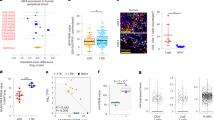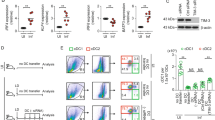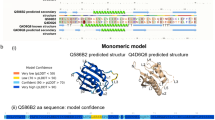Abstract
Here we identified B cells as a major source of rapid, innate-like production of interleukin 17 (IL-17) in vivo in response to infection with Trypanosoma cruzi. IL-17+ B cells had a plasmablast phenotype, outnumbered cells of the TH17 subset of helper T cells and were required for an optimal response to this pathogen. With both mouse and human primary B cells, we found that exposure to parasite-derived trans-sialidase in vitro was sufficient to trigger modification of the cell-surface mucin CD45, which led to signaling dependent on the kinase Btk and production of IL-17A or IL-17F via a transcriptional program independent of the transcription factors RORγt and Ahr. Our combined data suggest that the generation of IL-17+ B cells may be a previously unappreciated feature of innate immune responses required for pathogen control or IL-17-mediated autoimmunity.
This is a preview of subscription content, access via your institution
Access options
Subscribe to this journal
Receive 12 print issues and online access
$209.00 per year
only $17.42 per issue
Buy this article
- Purchase on Springer Link
- Instant access to full article PDF
Prices may be subject to local taxes which are calculated during checkout






Similar content being viewed by others
References
Korn, T., Bettelli, E., Oukka, M. & Kuchroo, V.K. IL-17 and Th17 cells. Annu. Rev. Immunol. 27, 485–517 (2009).
Gaffen, S.L. Recent advances in the IL-17 cytokine family. Curr. Opin. Immunol. 23, 613–619 (2011).
Kelly, M.N. et al. Interleukin-17interleukin-17 receptor-mediated signaling is important for generation of an optimal polymorphonuclear response against Toxoplasma gondii infection. Infect. Immun. 73, 617–621 (2005).
Pitta, M.G. et al. IL-17 and IL-22 are associated with protection against human kala azar caused by Leishmania donovani. J. Clin. Invest. 119, 2379–2387 (2009).
Rudner, X.L., Happel, K.I., Young, E.A. & Shellito, J.E. Interleukin-23 (IL-23)-IL-17 cytokine axis in murine Pneumocystis carinii infection. Infect. Immun. 75, 3055–3061 (2007).
da Matta Guedes, P.M. et al. IL-17 produced during Trypanosoma cruzi infection plays a central role in regulating parasite-induced myocarditis. PLoS Negl. Trop. Dis. 4, e604 (2010).
Miyazaki, Y. et al. IL-17 is necessary for host protection against acute-phase Trypanosoma cruzi infection. J. Immunol. 185, 1150–1157 (2010).
Mou, Z., Jia, P., Kuriakose, S., Khadem, F. & Uzonna, J.E. Interleukin-17-mediated control of parasitemia in experimental Trypanosoma congolense infection in mice. Infect. Immun. 78, 5271–5279 (2010).
Tosello Boari, J. et al. IL-17RA signaling reduces inflammation and mortality during Trypanosoma cruzi infection by recruiting suppressive IL-10-producing neutrophils. PLoS Pathog. 8, e1002658 (2012).
Cua, D.J. & Tato, C.M. Innate IL-17-producing cells: the sentinels of the immune system. Nat. Rev. Immunol. 10, 479–489 (2010).
Bryan, M.A., Guyach, S.E. & Norris, K.A. Specific humoral immunity versus polyclonal B cell activation in Trypanosoma cruzi infection of susceptible and resistant mice. PLoS Negl. Trop. Dis. 4, e733 (2010).
Bermejo, D.A. et al. Trypanosoma cruzi infection induces a massive extrafollicular and follicular splenic B-cell response which is a high source of non-parasite-specific antibodies. Immunology 132, 123–133 (2011).
Noelle, R.J., Ledbetter, J.A. & Aruffo, A. CD40 and its ligand, an essential ligand-receptor pair for thymus-dependent B-cell activation. Immunol. Today 13, 431–433 (1992).
Meyer-Bahlburg, A. & Rawlings, D.J. Differential impact of Toll-like receptor signaling on distinct B cell subpopulations. Front. Biosci. 17, 1499–1516 (2012).
Rawlings, D.J., Schwartz, M.A., Jackson, S.W. & Meyer-Bahlburg, A. Integration of B cell responses through Toll-like receptors and antigen receptors. Nat. Rev. Immunol. 12, 282–294 (2012).
Tarleton, R.L. Immune system recognition of Trypanosoma cruzi. Curr. Opin. Immunol. 19, 430–434 (2007).
Minoprio, P., Bandeira, A., Pereira, P., Mota Santos, T. & Coutinho, A. Preferential expansion of Ly-1 B and CD4−CD8− T cells in the polyclonal lymphocyte responses to murine T. cruzi infection. Int. Immunol. 1, 176–184 (1989).
Bermejo, D.A. et al. BAFF mediates splenic B cell response and antibody production in experimental Chagas disease. PLoS Negl. Trop. Dis. 4, e679 (2010).
Schenkman, S., Eichinger, D., Pereira, M.E. & Nussenzweig, V. Structural and functional properties of Trypanosoma trans-sialidase. Annu. Rev. Microbiol. 48, 499–523 (1994).
Gao, W., Wortis, H.H. & Pereira, M.A. The Trypanosoma cruzi trans-sialidase is a T cell-independent B cell mitogen and an inducer of non-specific Ig secretion. Int. Immunol. 14, 299–308 (2002).
Alvarez, P., Leguizamon, M.S., Buscaglia, C.A., Pitcovsky, T.A. & Campetella, O. Multiple overlapping epitopes in the repetitive unit of the shed acute-phase antigen from Trypanosoma cruzi enhance its immunogenic properties. Infect. Immun. 69, 7946–7949 (2001).
Risso, M.G., Pitcovsky, T.A., Caccuri, R.L., Campetella, O. & Leguizamon, M.S. Immune system pathogenesis is prevented by the neutralization of the systemic trans-sialidase from Trypanosoma cruzi during severe infections. Parasitology 134, 503–510 (2007).
Leguizamón, M.S., Mocetti, E., Garcia Rivello, H., Argibay, P. & Campetella, O. Trans. -sialidase from Trypanosoma cruzi induces apoptosis in cells from the immune system in vivo. J. Infect. Dis. 180, 1398–1402 (1999).
Buschiazzo, A. et al. Trypanosoma cruzi trans-sialidase in complex with a neutralizing antibody: structurefunction studies towards the rational design of inhibitors. PLoS Pathog. 8, e1002474 (2012).
Muiá, R.P. et al. Identification of glycoproteins targeted by Trypanosoma cruzi trans-sialidase, a virulence factor that disturbs lymphocyte glycosylation. Glycobiology 20, 833–842 (2010).
Mucci, J., Risso, M.G., Leguizamon, M.S., Frasch, A.C. & Campetella, O. The trans-sialidase from Trypanosoma cruzi triggers apoptosis by target cell sialylation. Cell. Microbiol. 8, 1086–1095 (2006).
Kaneko, Y., Nimmerjahn, F. & Ravetch, J.V. Anti-inflammatory activity of immunoglobulin G resulting from Fc sialylation. Science 313, 670–673 (2006).
Kuijf, M.L. et al. TLR4-mediated sensing of Campylobacter jejuni by dendritic cells is determined by sialylation. J. Immunol. 185, 748–755 (2010).
Rabinovich, G.A. & Toscano, M.A. Turning 'sweet' on immunity: galectin-glycan interactions in immune tolerance and inflammation. Nat. Rev. Immunol. 9, 338–352 (2009).
Earl, L.A. & Baum, L.G. CD45 glycosylation controls T-cell life and death. Immunol. Cell Biol. 86, 608–615 (2008).
Zuñiga, E., Rabinovich, G.A., Iglesias, M.M. & Gruppi, A. Regulated expression of galectin-1 during B-cell activation and implications for T-cell apoptosis. J. Leukoc. Biol. 70, 73–79 (2001).
Acosta-Rodríguez, E.V. et al. Galectin-3 mediates IL-4-induced survival and differentiation of B cells: functional cross-talk and implications during Trypanosoma cruzi infection. J. Immunol. 172, 493–502 (2004).
Gao, W. & Pereira, M.A. Trypanosoma cruzi trans-sialidase potentiates T cell activation through antigen-presenting cells: role of IL-6 and Bruton's tyrosine kinase. Eur. J. Immunol. 31, 1503–1512 (2001).
Rawlings, D.J., Sommer, K. & Moreno-Garcia, M.E. The CARMA1 signalosome links the signalling machinery of adaptive and innate immunity in lymphocytes. Nat. Rev. Immunol. 6, 799–812 (2006).
Moreno-García, M.E., Sommer, K.M., Bandaranayake, A.D. & Rawlings, D.J. Proximal signals controlling B-cell antigen receptor (BCR) mediated NF-κB activation. Adv. Exp. Med. Biol. 584, 89–106 (2006).
Dong, C. Genetic controls of Th17 cell differentiation and plasticity. Exp. Mol. Med. 43, 1–6 (2011).
Esser, C., Rannug, A. & Stockinger, B. The aryl hydrocarbon receptor in immunity. Trends Immunol. 30, 447–454 (2009).
Eberl, G. & Littman, D.R. Thymic origin of intestinal αβ T cells revealed by fate mapping of RORgammat+ cells. Science 305, 248–251 (2004).
He, Y.W., Deftos, M.L., Ojala, E.W. & Bevan, M.J. RORγt, a novel isoform of an orphan receptor, negatively regulates Fas ligand expression and IL-2 production in T cells. Immunity 9, 797–806 (1998).
Hermiston, M.L., Xu, Z. & Weiss, A. CD45: a critical regulator of signaling thresholds in immune cells. Annu. Rev. Immunol. 21, 107–137 (2003).
Hernandez, J.D., Klein, J., Van Dyken, S.J., Marth, J.D. & Baum, L.G. T-cell activation results in microheterogeneous changes in glycosylation of CD45. Int. Immunol. 19, 847–856 (2007).
Andrews, S.F. & Rawlings, D.J. Transitional B cells exhibit a B cell receptor-specific nuclear defect in gene transcription. J. Immunol. 182, 2868–2878 (2009).
Rawlings, D.J. et al. Activation of BTK by a phosphorylation mechanism initiated by SRC family kinases. Science 271, 822–825 (1996).
Rawlings, D.J. Bruton's tyrosine kinase controls a sustained calcium signal essential for B lineage development and function. Clin. Immunol. 91, 243–253 (1999).
Li, L. et al. IL-17 produced by neutrophils regulates IFN-γ-mediated neutrophil migration in mouse kidney ischemia-reperfusion injury. J. Clin. Invest. 120, 331–342 (2010).
Yu, H. et al. A multifunctional Pasteurella multocida sialyltransferase: a powerful tool for the synthesis of sialoside libraries. J. Am. Chem. Soc. 127, 17618–17619 (2005).
Cheng, J. et al. Multifunctionality of Campylobacter jejuni sialyltransferase CstII: characterization of GD3GT3 oligosaccharide synthase, GD3 oligosaccharide sialidase, and trans-sialidase activities. Glycobiology 18, 686–697 (2008).
Gut, H., King, S.J. & Walsh, M.A. Structural and functional studies of Streptococcus pneumoniae neuraminidase B: An intramolecular trans-sialidase. FEBS Lett. 582, 3348–3352 (2008).
Cheng, J. et al. Trans. -sialidase activity of Photobacterium damsela α2,6-sialyltransferase and its application in the synthesis of sialosides. Glycobiology 20, 260–268 (2010).
Gutierrez, F.R., Guedes, P.M., Gazzinelli, R.T. & Silva, J.S. The role of parasite persistence in pathogenesis of Chagas heart disease. Parasite Immunol. 31, 673–685 (2009).
Norris, K.A., Schrimpf, J.E. & Szabo, M.J. Identification of the gene family encoding the 160-kilodalton Trypanosoma cruzi complement regulatory protein. Infect. Immun. 65, 349–357 (1997).
Campetella, O.E., Uttaro, A.D., Parodi, A.J. & Frasch, A.C. A recombinant Trypanosoma cruzi trans-sialidase lacking the amino acid repeats retains the enzymatic activity. Mol. Biochem. Parasitol. 64, 337–340 (1994).
Solt, L.A. et al. Suppression of TH17 differentiation and autoimmunity by a synthetic ROR ligand. Nature 472, 491–494 (2011).
Livak, K.J. & Schmittgen, T.D. Analysis of relative gene expression data using real-time quantitative PCR and the 2−ΔΔCT method. Methods 25, 402–408 (2001).
Acknowledgements
We thank K. Norris (University of Pittsburgh) for T. cruzi, Y strain; A. Weiss (University of California at San Francisco) for Cd45−/− mice; G. Sonnenberg (University of Pennsylvania) and D. Artis (University of Pennsylvania) for Il17a−/− mice; O. Campetella (Universidad de San Martín) for the trans-sialidase-neutralizing mAb (hybridoma 13G9); T. Burris (The Scripps Research Institute) for the inhibitor SR1001; N. Scharping and F. Fiocca-Vernengo for technical assistance; K. Sommer and M. Schwartz and other members of the Rawlings laboratory for suggestions and discussions; P. Abadie and MP Crespo for cell sorting; and F. Navarro for animal care in Argentina. Supported by the US National Institutes of Health (HD037091, HL075453, AI084457 and AI071163 to D.J.R.; AI 075589 to O.C.; and 5T32AR007108 and K12HD043376 to S.W.J.), the Rheumatology Research Foundation (S.W.J.), Consejo Nacional de Investigaciones Científicas y Técnicas, Agencia Nacional de Promoción Científica y Tecnológica (Fondo para la Investigación Científica y Tecnológica) and Secretaría de Ciencia y Tecnología de la Universidad Nacional de Córdoba (A.G.) and Consejo Nacional de Investigaciones Científicas y Técnicas (D.A.B., M.C.A.-V. and M.G.-S.).
Author information
Authors and Affiliations
Contributions
D.A.B. did experiments and analyzed the results; S.W.J. did experiments, including cell-transfer studies, immunohistochemistry and additional analyses; M.G.-S. assisted with trypomastigote cultures and studies of T. cruzi–infected μMT mice; M.C.A.-V. did quantitative PCR studies and analysis; B.D.S. established and assisted with human tonsillar assays; A.K.S. did quantitative PCR studies and IL-17-related assays; S.K. assisted with mouse-colony management and cell-transfer experiments; D.L. did and interpreted tissue histopathology studies; J.M. and O.C. provided trans-sialidase and anti-trans-sialidase, and technical and intellectual contributions to assays of sialylation and desialylation; E.V.A.-R. and M.O. contributed to study design and analysis; A.G. and D.J.R. conceived of, designed and supervised the study; S.W.J., E.V.A.-R., A.G. and D.J.R. wrote the manuscript; and all authors reviewed the manuscript before submission.
Corresponding authors
Ethics declarations
Competing interests
The authors declare no competing financial interests.
Supplementary information
Supplementary Text and Figures
Supplementary Figures 1–4 (PDF 1672 kb)
Rights and permissions
About this article
Cite this article
Bermejo, D., Jackson, S., Gorosito-Serran, M. et al. Trypanosoma cruzi trans-sialidase initiates a program independent of the transcription factors RORγt and Ahr that leads to IL-17 production by activated B cells. Nat Immunol 14, 514–522 (2013). https://doi.org/10.1038/ni.2569
Received:
Accepted:
Published:
Issue Date:
DOI: https://doi.org/10.1038/ni.2569
This article is cited by
-
Increased plasmablasts enhance T cell-mediated beta cell destruction and promote the development of type 1 diabetes
Molecular Medicine (2022)
-
Vaccination with Mycoplasma pneumoniae membrane lipoproteins induces IL-17A driven neutrophilia that mediates Vaccine-Enhanced Disease
npj Vaccines (2022)
-
The possible role of Interleukin-6 as a regulator of insulin sensitivity in patients with neuromyelitis optica spectrum disorder
BMC Neurology (2021)
-
B cell depletion therapies in autoimmune disease: advances and mechanistic insights
Nature Reviews Drug Discovery (2021)
-
Oral P. gingivalis impairs gut permeability and mediates immune responses associated with neurodegeneration in LRRK2 R1441G mice
Journal of Neuroinflammation (2020)



